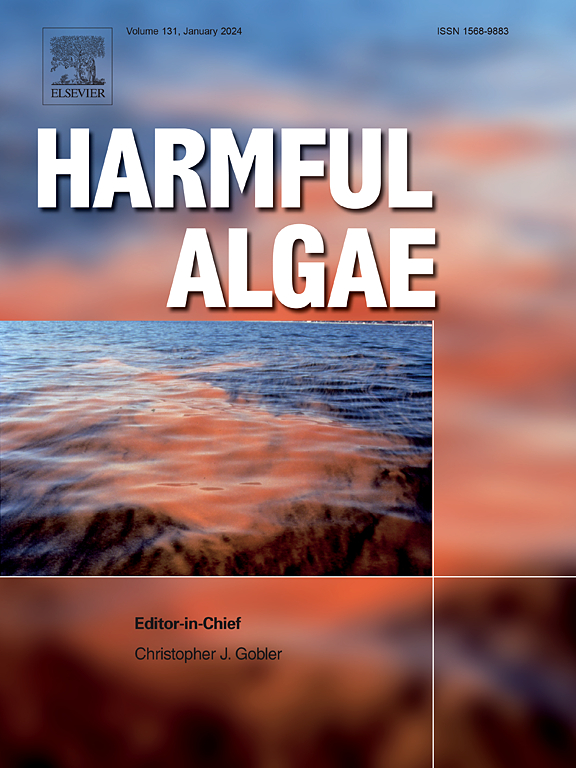Transcriptional responses to oxygen gradients in cyanobacterial aggregates
IF 4.5
1区 生物学
Q1 MARINE & FRESHWATER BIOLOGY
引用次数: 0
Abstract
Cyanobacterial aggregates (CAs) are the main cause of harmful cyanobacterial blooms in freshwater lakes, posing serious risks to water quality and ecosystem health. The ecological success of CAs is closely linked to their abilities to adapt to fluctuating dissolved oxygen (DO) levels. In this study, we investigated the transcriptional responses of CA-associated microbial communities across a gradient of DO concentrations (0–6 mg/L) using incubation experiments combined with 16S rRNA transcript and metatranscriptomic sequencing. Distinct transcriptional patterns of clusters of genes were revealed for both cyanobacterial and phycospheric communities. Notably, Microcystis, the dominating cyanobacteria in the CAs, demonstrated markedly elevated transcriptional activities under oxygen-deficient conditions. Under low DO, cyanobacteria actively cope with reactive oxygen species (ROS) stress, and utilized fermentation and O2-independent alternative electron sink to maintain anaerobic metabolism. Upregulation of gas vesicle protein genes also suggests a role in buoyancy regulation to escape low-oxygen zones. These transcriptomic findings were further supported by physiological assays of Microcystis, which exhibited increased ROS level, extracellular polysaccharides (EPS) content and alcohol production under oxygen-deficient conditions. Moreover, intensified competition for nutrients between cyanobacteria and phycospheic bacteria under low DO were revealed, although the latter may also support cyanobacterial growth through cobalamin (vitamin B12) provisioning. Collectively, our findings uncover key adaptive responses of Microcystis under oxygen-deficient conditions and underscore the importance of redox regulation in shaping the metabolic dynamics of CA-associated microbial communities.

蓝藻聚集体对氧梯度的转录反应
蓝藻聚集体(CAs)是淡水湖泊有害蓝藻繁殖的主要原因,对水质和生态系统健康构成严重威胁。CAs的生态成功与它们适应溶解氧(DO)水平波动的能力密切相关。在这项研究中,我们通过结合16S rRNA转录和亚转录组测序的培养实验,研究了ca相关微生物群落在DO浓度梯度(0-6 mg/L)下的转录反应。在蓝藻和藻圈群落中发现了不同的基因簇转录模式。值得注意的是,微囊藻,在CAs中占主导地位的蓝藻,在缺氧条件下表现出显著升高的转录活性。在低DO条件下,蓝藻积极应对活性氧(ROS)胁迫,利用发酵和不依赖o2的替代电子汇维持厌氧代谢。气体囊泡蛋白基因的上调也提示在浮力调节中起作用,以逃离低氧区。这些转录组学研究结果进一步得到了微囊藻生理测试的支持,在缺氧条件下,微囊藻的ROS水平、胞外多糖(EPS)含量和酒精产量均有所增加。此外,在低DO条件下,蓝藻和藻球细菌之间对营养物质的竞争加剧,尽管后者也可能通过提供钴胺素(维生素B12)来支持蓝藻的生长。总的来说,我们的发现揭示了微囊藻在缺氧条件下的关键适应性反应,并强调了氧化还原调节在形成ca相关微生物群落代谢动力学中的重要性。
本文章由计算机程序翻译,如有差异,请以英文原文为准。
求助全文
约1分钟内获得全文
求助全文
来源期刊

Harmful Algae
生物-海洋与淡水生物学
CiteScore
12.50
自引率
15.20%
发文量
122
审稿时长
7.5 months
期刊介绍:
This journal provides a forum to promote knowledge of harmful microalgae and macroalgae, including cyanobacteria, as well as monitoring, management and control of these organisms.
 求助内容:
求助内容: 应助结果提醒方式:
应助结果提醒方式:


